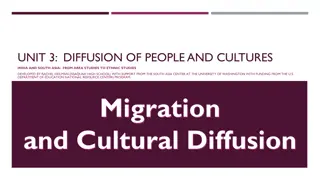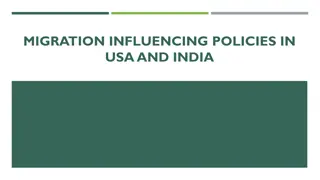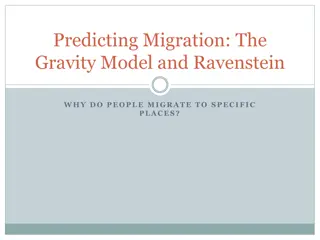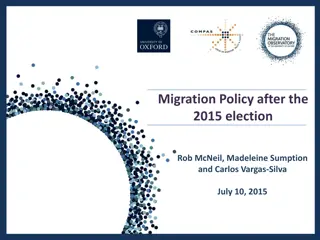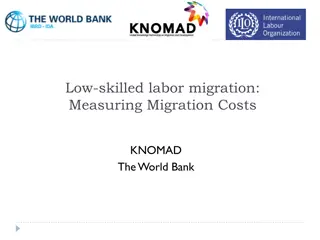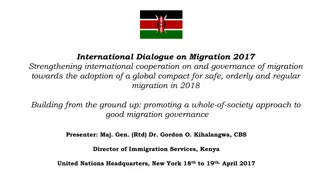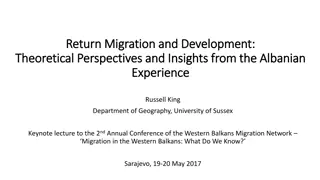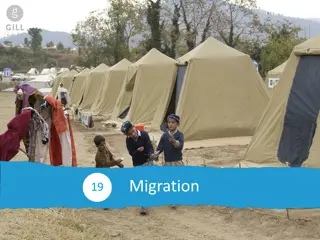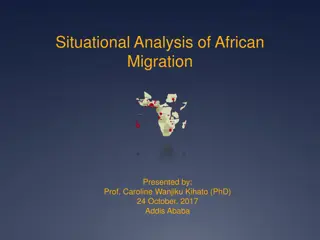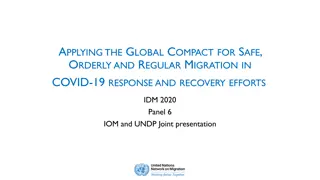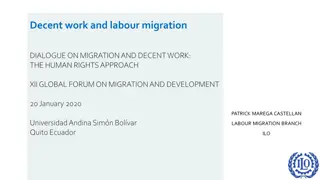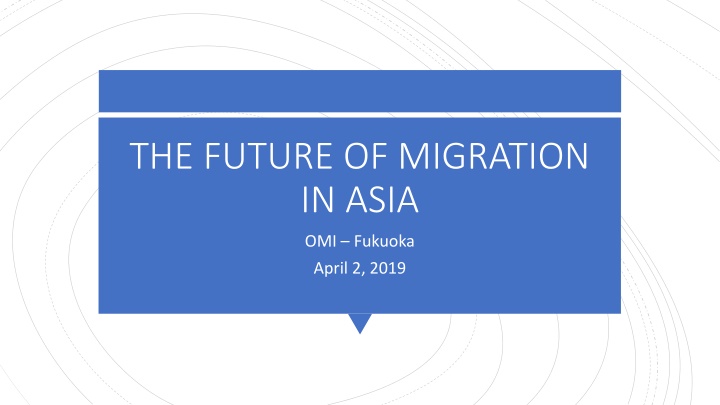
The Future of Migration in Asia: Statistics and Trends
Migration trends in Asia, including statistics on migrants, changes in migrant stock by region, migration patterns within Asia, and China's dominance in East Asia. Understand the impact of migration on population growth.
Download Presentation

Please find below an Image/Link to download the presentation.
The content on the website is provided AS IS for your information and personal use only. It may not be sold, licensed, or shared on other websites without obtaining consent from the author. If you encounter any issues during the download, it is possible that the publisher has removed the file from their server.
You are allowed to download the files provided on this website for personal or commercial use, subject to the condition that they are used lawfully. All files are the property of their respective owners.
The content on the website is provided AS IS for your information and personal use only. It may not be sold, licensed, or shared on other websites without obtaining consent from the author.
E N D
Presentation Transcript
THE FUTURE OF MIGRATION IN ASIA OMI Fukuoka April 2, 2019
MIGRATION IN ASIA IN 2017 In 2017, there were about 79.6 million migrants in Asia, who correspond to 30 percent of the 257.7 million total in the world. 53 percent of the migrants in Asia are in Western Asia and particularly in the Gulf Cooperation Council countries (43 percent). The median age of male migrants in the world was 36.4 in 2017, the same as in Asia. The median age of female migrants in the world was 39,9, but much lower for female migrants in Asia (31.4) Overall, 48.4 percent of migrants in the world were women. In Asia, the percentage was 42.4, and below 30 percent in the GCC countries. Almost three quarters of international migrants in Asia are in just fifteen countries
CHANGE OF MIGRANTS STOCK BY REGION 2000 2017 Total Share Annual change increase 279,100 Central Asia 5,183,872 5,462,972 6.9 0.3 Eastern Asia 5,393,081 7,776,716 2,383,635 9.8 2.2 Southern Asia 15,278,020 13,582,402 -1,695,618 17.1 -0.7 South-Eastern Asia 4,926,833 9,873,600 4,946,767 12.4 4.2 GCC Countries 10,060,368 28,138,572 18,078,204 35.4 6.2 Other Western Asia 8,356,158 14,752,447 6,396,289 18.5 3.4 Total 49,198,332 79,586,709 30,388,377 100.0 2.9
MIGRATION FROM, TO AND WITHIN From Within To Other Asian region Non-Asian countries Other Asian regions Non-Asian countries Central Asia Eastern Asia Southern Asia Southeast Asia GCC Countries 277,180 4,694,926 490,866 132,014 7,025,372 1,366,004 1,119,179 5,291,533 1,265,827 8,103,719 1,251,395 882,397 11,448,610 18,556,761 4,743,589 2,192,801 846,300 6,834,499 5,973,738 8,276,757 23,537,065 4,507,271 94,236 155,645 482,563
CHINA DOMINATES MIGRATION IN EAST ASIA CHINA DOMINATES MIGRATION IN EAST ASIA East Asia is origin of 14.6 million migrants, mostly from China (9.9 million) and Korea (2.5 million) to other regions. Of them, 5.3 million remain within the region, particularly Chinese in Hong Kong (2.3 million) but also in Japan (741,022) and Korea (614,012) and Koreans in Japan (593,449). East Asia is instead the destination of 7.8 million migrants, mostly to Hong Kong (2.9 million), Japan (2.3 million) and Korea (1.1 million). In Japan, the largest group, after the Chinese and Koreans, are the Filipinos (238,797), while in Korea, after the Chinese, it is the Vietnamese (114,462). East Asia presents historical dynamics (Chinese to Hong Kong, Koreans to Japan), but also migration driven by labor movements and family migration (Chinese and Filipinos in Japan, Chinese and Vietnamese in Korea). In addition to Hong Kong, Japan and Korea, migrants from China are in Singapore, UK, Italy, and the US (2,422,998).
POPULATION AND MIGRATION GROWTH Migration impact Migration impact 2017 2025 2025 2040 2040 Zero Zero Population Population Population migration migration Central Asia 70,840 78,223 78,855 (632) 88,711 90,479 (1,768) Eastern Asia 1,677,633 1,679,731 (2,098) 1,648,802 1,654,572 (5,770) 1,648,165 Southern Asia Southeast Asia GCC Countries 2,040,509 2,055,084 (14,575) 2,283,936 2,320,756 (36,820) 1,868,985 648,780 700,417 703,621 (3,204) 770,770 779,348 (8,578) 55,243 62,792 59,137 3,655 72,394 64,683 7,711
New technologies could cause a widespread loss of jobs, particularly in repetitive tasks, but also the creation of new skills The growth of GDP throughout Asia will remain stable in the short term Uncertainties because of the tariffs war between US and China The workforce in the continent is aging, while the share of the 15-24 age group is declining Unemployment is higher among the youth, but the real concern is underemployment Employment will grow in health and education THE ECONOMIC CONTEXT
GDP Growth Rate, % per year, Per Capita GNI GDP Growth Rate, % per year, Per Capita GNI and Youth Unemployment rate and Youth Unemployment rate Youth Unem- ployment Remitta nces % of GDP 2016 Per capita GNI, $, 2016 2013 2014 2015 2016 2017 2018 2019 Bangladesh Cambodia PRC India Indonesia Lao Myanmar Nepal Pakistan Philippines Sri Lanka Viet Nam 6.0 7.4 7.8 6.4 5.6 8.0 8.4 3.8 3.7 7.1 3.4 5.4 6.1 7.1 7.3 7.4 5.0 7.6 8.0 5.7 4.1 6.1 5.0 6.0 6.6 7.0 6.9 8.2 4.9 7.3 7.0 3.0 4.1 6.1 5.0 6.7 6.1 7.0 6.7 7.1 5.0 7.0 5.9 0.0 4.5 6.9 4.5 6.2 7.3 7.0 6.9 6.6 5.1 6.8 6.8 6.9 5.3 6.7 3.1 6.8 7.0 7.0 6.6 7.3 5.3 6.8 6.8 4.9 5.6 6.8 4.2 7.1 7.2 7.0 6.4 7.6 5.3 7.0 7.2 5.5 5.1 6.9 4.8 6.8 1,330 1,140 8,250 1,670 3,400 2,150 1,190 730 1,500 3,580 3,780 2,100 9.9 6.2 1.6 0.3 2.8 1.0 0.6 4.9 29.7 7.1 10.2 8.9 6.6 10.1 10.1 22.6 1.6 2.2 6.6 15.0 20.7 7.0
Annual outflow of migrants from selected Annual outflow of migrants from selected Asian countries ( 000) Asian countries ( 000) 2007 2008 2009 2010 2011 2012 2013 2014 2015 2016 Bangladesh 820 875 475 391 568 608 409 426 556 758 Cambodia 9 9 15 30 26 35 23 25 41 85 PRC 372 427 395 411 452 512 527 562 530 494 India 809 849 610 641 627 747 817 805 781 521 Indonesia 690 636 630 575 581 495 512 430 276 235 Lao PDR 3 2 4 19 34 7 23 8 51 58 Myanmar 8 12 6 5 18 68 67 65 95 146 Nepal 205 249 220 294 355 385 451 520 500 403 Pakistan Philippines1 282 425 396 363 456 635 622 754 775 839 716 870 991 1,124 1,319 1,435 1,469 1,431 1,438 1,670 Sri Lanka 218 250 247 268 263 282 293 301 263 243 Viet Nam 64 87 73 86 88 80 88 107 120 126
Destination of migrants from selected Asian Destination of migrants from selected Asian countries, 2016 countries, 2016
THE POLITICAL CONTEXT Labor migration in Asia will remain temporary In the GCC countries, no drastic changes are expected in the kafala system There will be a possible decline of migration to South Korea, if the two Korean countries normalize their relations Policies in countries of origin will have an increasing impact on the migration trends and policies of destination countries The unwillingness of Myanmar to give citizenship to Rohingyas will maintain their insecurity
Temporary displacements because of environmental disasters will be more frequent Various countries of origin are considered high risk because of natural or human causes and therefore subject to displacements Destination countries are less subject to risk than origin countries THE ENVIRONMENT CONTEXT
THE IMPACTS OF MIGRATION: ECONOMIC Asia benefits widely from remittances from migrants. In the World Bank s most recent report (2018), remittances amounted to USD466 billion in 2017. Of the top 10 receiving countries, seven are in Asia: India, China, the Philippines, Pakistan, Vietnam, Bangladesh and Indonesia Some countries show dependence on remittances. Dependence is measured as the share of remittances to GDP To increase the impact of remittances on the national economies, opportunities must be created which the migrants can utilize Social remittances are useful but less sustainable Brain drain and brain gain remain difficult to assess Migrants contribute to the economy of the world: in 2015, international migrants constituted 3.4 percent of the world s population, but contributed 9.4 percent ($6.7 trillion) to the global GDP (McKinsey Global Institute)
Remittance inflows and share of remittances to GDP, 2017, by region/country Region/Country East and Southeast Asia China Philippines Vietnam Indonesia Thailand Malaysia Myanmar Cambodia Mongolia Remittances, 2017 (USD billion) Percentage of GDP, 2017 63.9 32.8 13.8 9.0 6.7 1.6 0.7 0.4 0.3 0.3 (2016) 10.2 6.4 1.0 (2016) 1.5 (2016) 0.5 (2016) 1.1 (2016) 1.9 (2016) 2.5
Migration transforms the family of migrants. Family reunification will still be off-limits to migrant workers Marriage migration will increase in East Asia and have various social impacts Migration has reconfigured gender roles in transnational families during the time of migration THE IMPACTS OF MIGRATION: SOCIAL
MIGRATION GOVERNANCE Migration governance in Asia rests on national migration policies Migration policies are imperfect instruments for the governance of migration Improving the governance of migration requires cooperation at different levels The consultative processes are useful but not very effective Regional structures are more effective but are still timid about migration Bilateral agreements remain the most effective way to ensure protection to migrants but are poorly implemented and monitored International instruments for the protection of migrants are ratified by only a few countries in Asia The global compacts: a platform for an international approach to migrants and refugees?
Outbreaks of potential intrastate and interstate conflicts could fuel movement of asylum seekers Increasing urbanization will serve as a magnet for migration flows Shifting of power at the global and regional level Climate change will remain a potential source of internal displacement and a driver for cross border migration The demand for migrants will continue but perhaps at a lower rate in the GCC countries while it will likely increase in East Asia Increasing population movements will require some adaptation to cultural pluralism Possible regional scenarios and their impact on migration
What will be the short, medium forecast concerning migration? Who are the neediest migrants now and in the near future? What are the recent trends in Japan and Korea? Workshop


